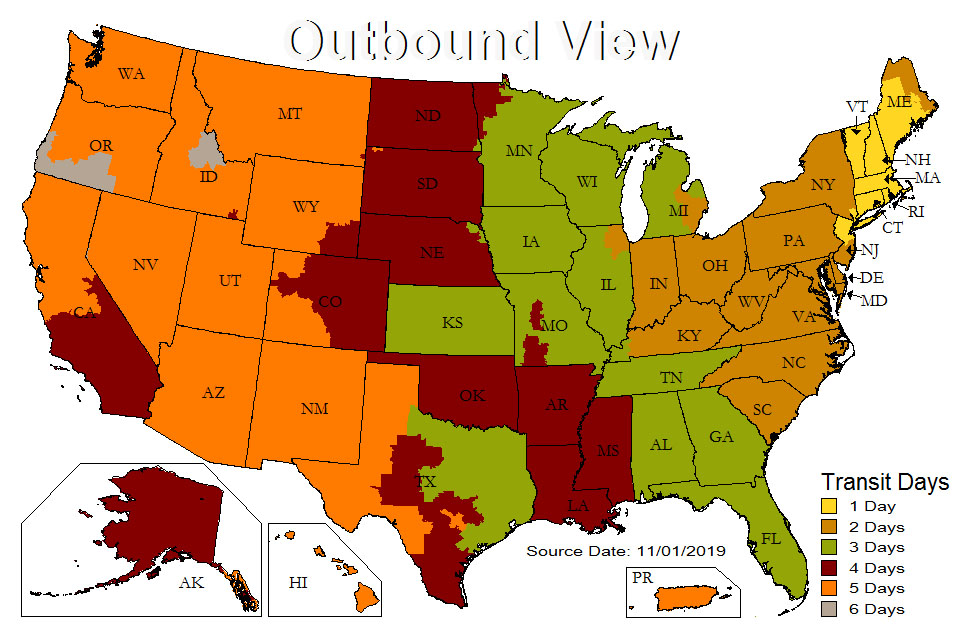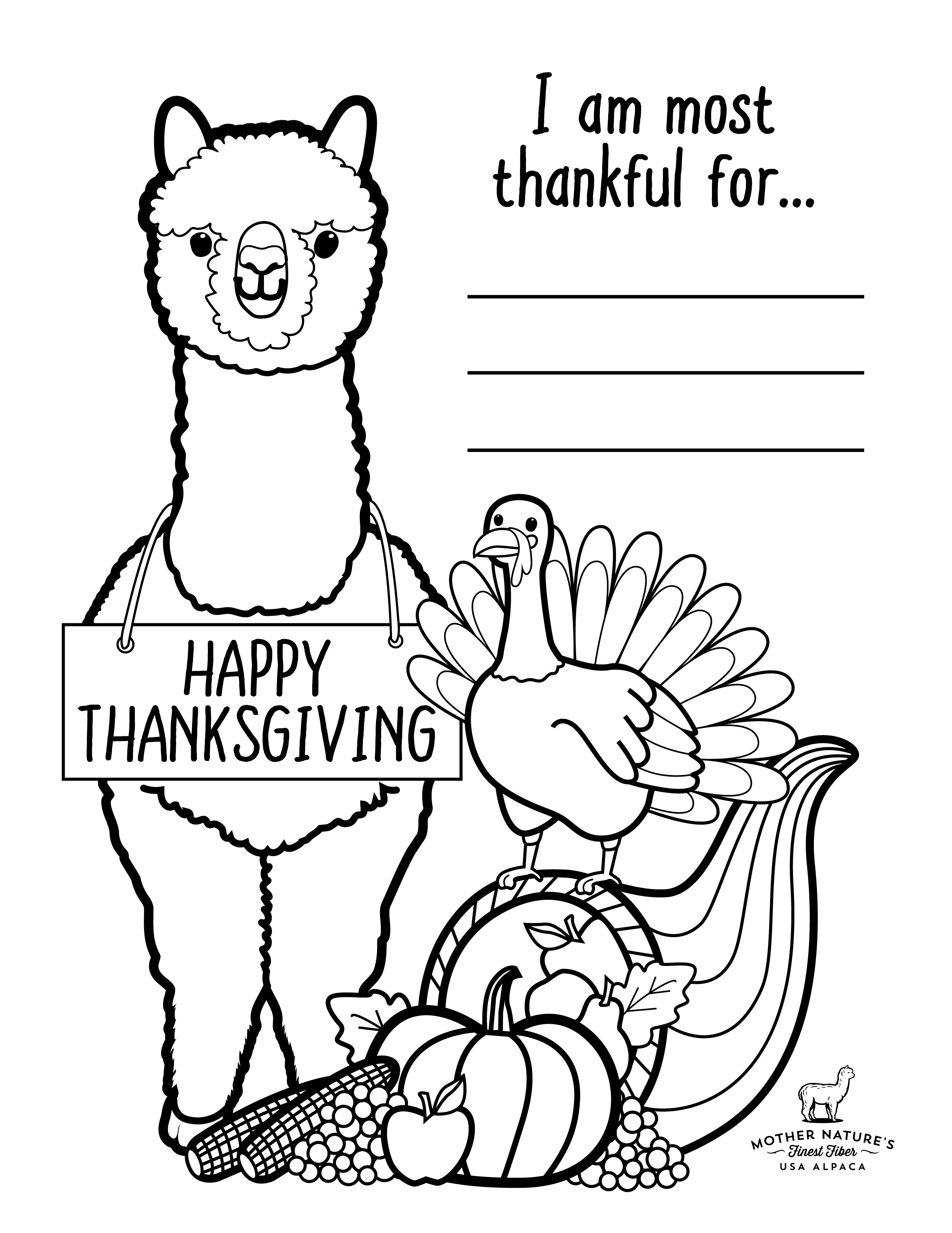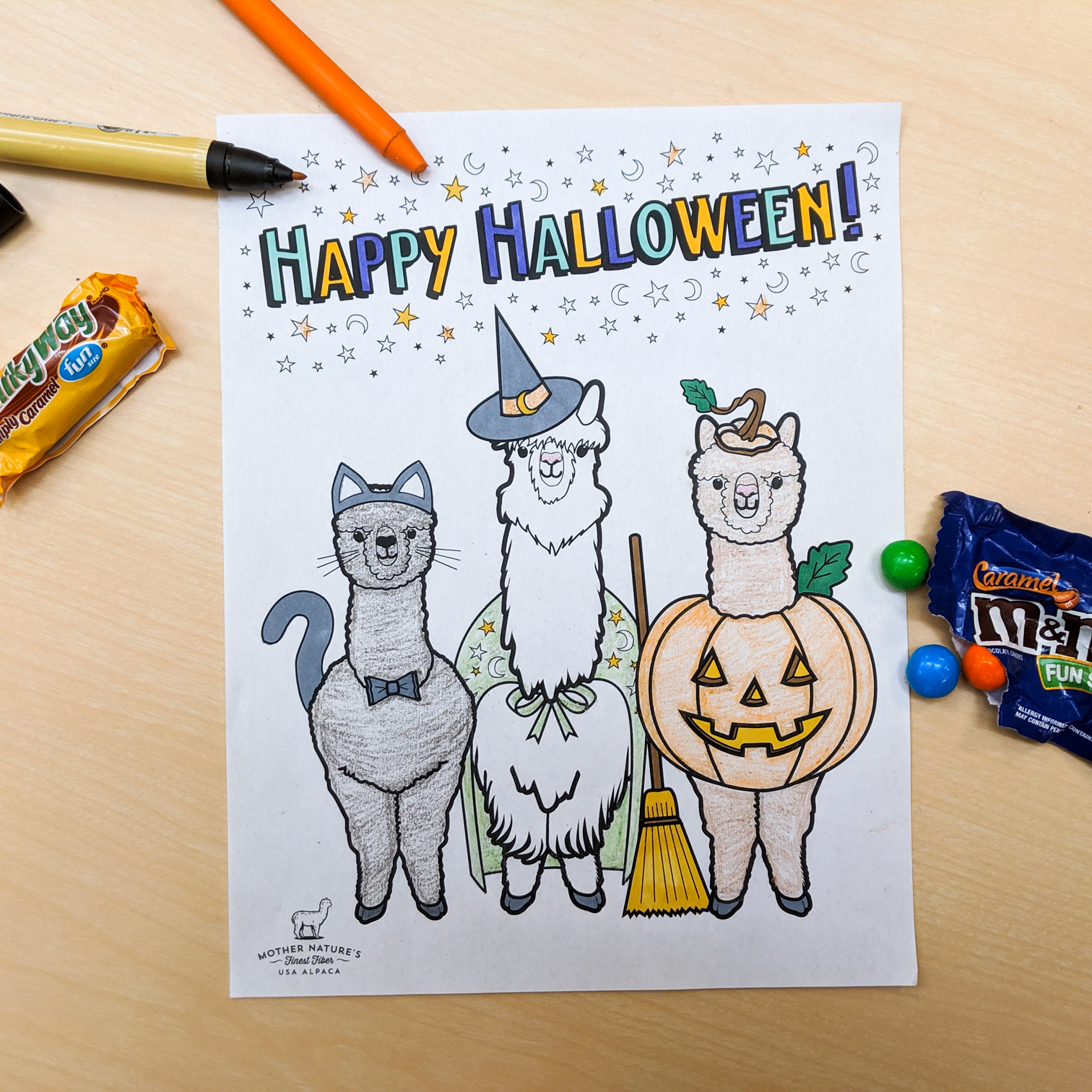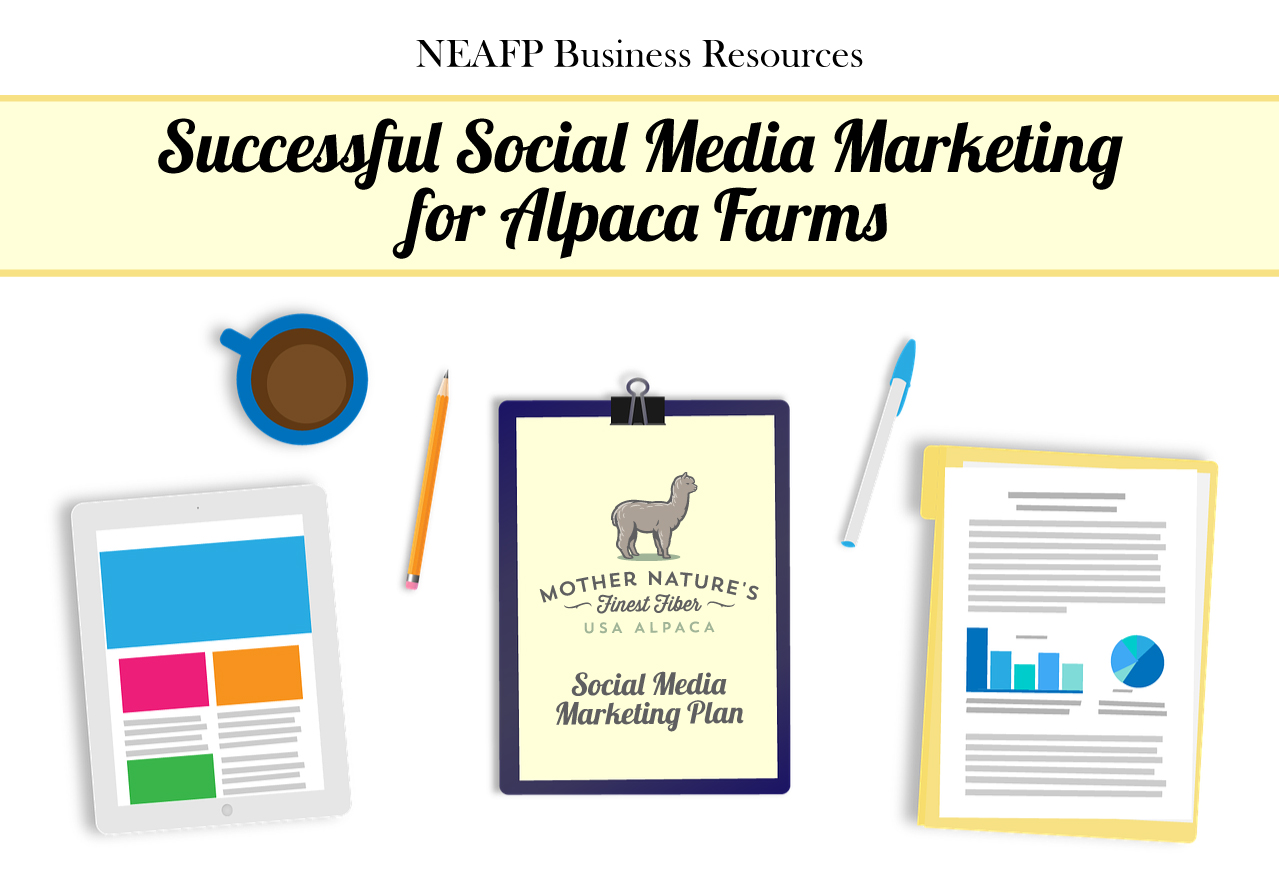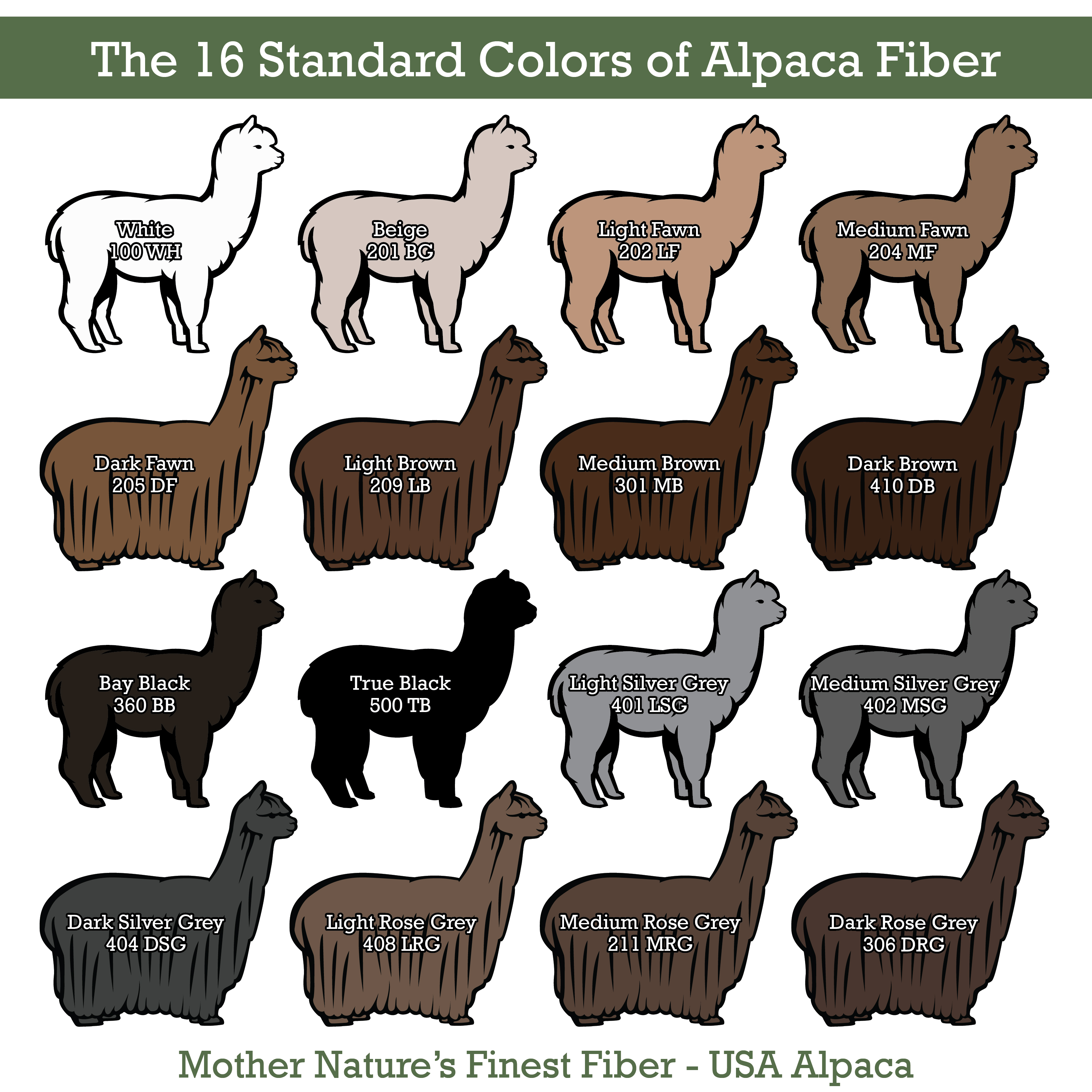Recent Blog Posts
-
06/26/2025NEW Downloadable Content: Find the Difference Activity Page
-
04/25/2025VIDEO: Take a Virtual Tour of our Mill!
-
01/17/2025Reviews: What People are Saying About The Survival Sock!
-
09/13/2024Download A Free Handwear Informational Print Out!
-
09/13/2024NEW Downloadable Content: Know Your Alpacas! Coloring Page
-
08/16/2024NEW Downloadable Content: National Alpaca Farm Days Word Search
-
06/21/2024VIDEO: What to Expect When You Submit Your Fiber to NEAFP
-
05/24/2024VIDEO: Getting Started Submitting Alpaca Fiber
Alpaca Coloring Pages
- Happy Memorial Day 2024: Alpaca's Grazing
- Winter #1: Build a Snowman Activity
- Winter #2: Extreme Sports
- Valentine's Day: Alpaca Wedding
- St. Patrick's Day: Leprechaun
- Spring: April Showers
- Summer: Beach Day
- 4th of July: Colonial Alpacas
- Summer: Farmer's Market
- Fall: Apple Picking
- Halloween #1: Costume Contest
- Halloween #2: Spooktacular Halloween
- Thanksgiving #1: Giving Thanks Activity
- Thanksgiving #2: Pilgrim Alpacas
- Christmas #1: Deck the Halls
- Christmas #2: Santa's Workshop
Alpaca Fact Series
Business Resources
- Article: Email is still a MUST DO for all Alpaca Farms
- Article: Off the Beaten Path Event Ideas on the Alpaca Farm
- Download: Sock Photo Download Folder
- Graphics: Shop Small this Holiday Season
- Article: Form Follows Function: Dressing for Fall and Winter 2020
- Graphics: Sock and Handwear Comparisons
- Article: A Change in the Seasons: Farms Continue to Adapt into the Busy Harvest Season
- Graphics: How to Support Alpaca Farms
- Graphics: Alpaca Fiber Properties
- Article: Customer Retention: Building Customer Loyalty for your Ecommerce Business
- Article: Harnessing Storytelling to Market Your Business
- Article: The New Normal and a Renewed Support for U.S. Alpaca
- Article: Use Gift Cards to Increase Sales
- Article: Virtual Farm Tours: Bringing People & Alpacas Together in the Virtual World
- Graphics: Get the Most out of your Fiber Harvest
- Graphics: Alpaca Knitter's Yarn Guide
- Article: Mike and Sean's Adventure in Retailing
- Article: Harnessing Holiday Sales Momentum into the New Year
- Graphics: U.S. Alpaca Holiday Gift Guide
- Graphics: Small Business Saturday Resources
- Article: Tools and Topics for Implementing Healthy Soil Agriculture
- Article: Successful Social Media Marketing for Alpaca Farms
- Article: Agritourism on the Alpaca Farm
- Article: Finding Success at Fall and Winter Markets
- Article: Brand Identity & Your Local Community
- Article: Social Media: Alpacas are STILL Seriously Trending
- Article: Let's Get Personal: Expanding your Inventory with Product Personalization
- Article: Part 2: Promoting your Brand Online through Product Styling
- Article: Promoting your Brand Online through Product Styling
- Article: 7 Old School Ways to Spread the Word about your Event
- Article: 5 Ways your Open House can increase Future Sales
- Article: Top Alpaca Related Hashtags to increase your Reach!
- Article: Alpacas are SERIOUSLY Trending
- Article: How to Utilize CO-MARKETING
- Article: Farmers Share their Booths and Tips
- Article: Mobile Payment Survey Results
- Article: Product Photography Do’s and Don'ts
- Article: Driving Business After the Holidays
- Article: Marketing Reflection and Planning
- Article: The Slow Alpaca meets Slow Fashion
- Article: Use Gift Cards to Increase Sales
- Article: The Importance of Being Mobile Friendly
News
NEW Downloadable Content: February Coloring Page!
Love is in the Air...
Cupid's alpaca arrow has struck these two alpacas! If you're a romantic at heart, you'll love our February coloring page!
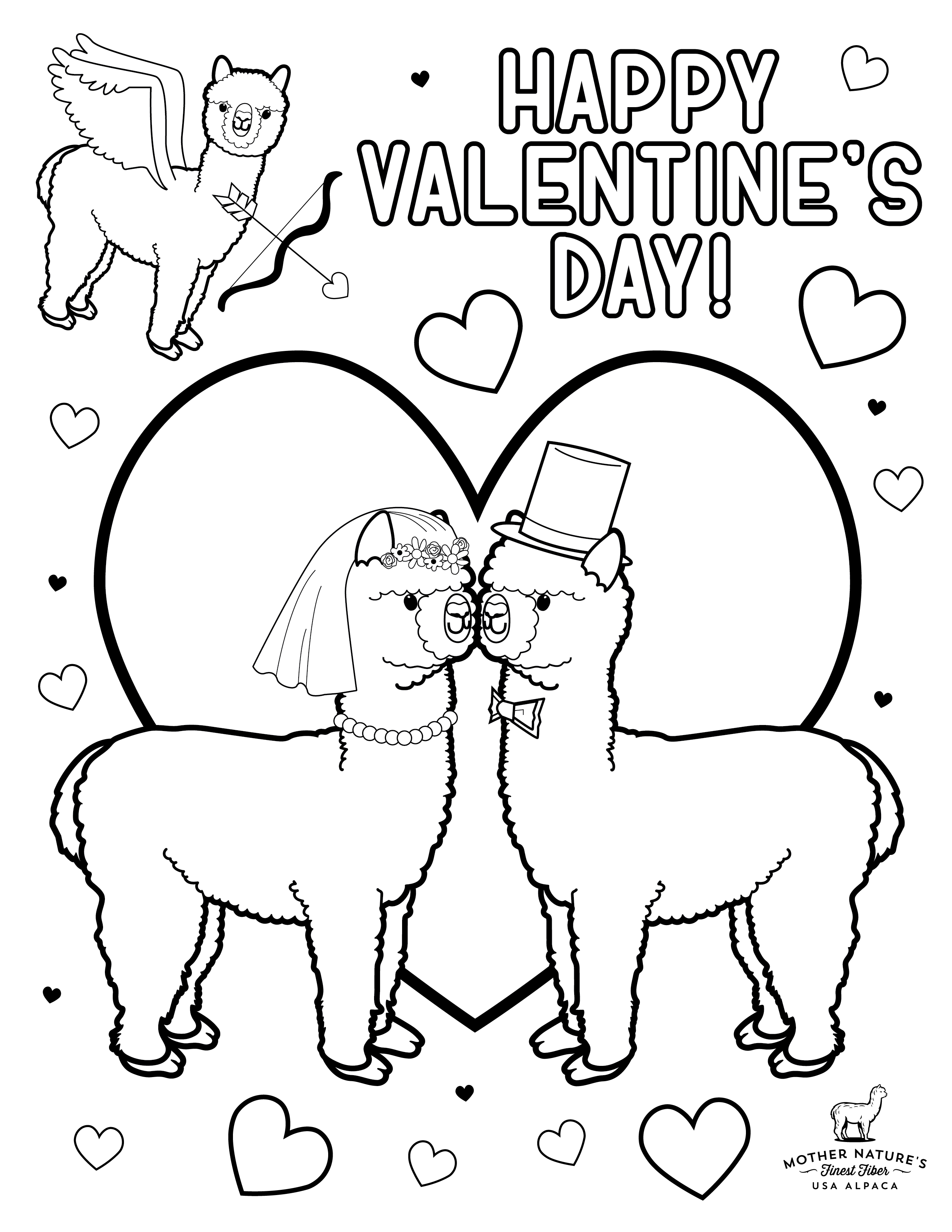
Winter markets and open houses continue into the new year!... Hoping to entertain your youngest alpaca fans?
We've got you covered with a free downloadable coloring page!

Find it here on Facebook, or download a full-size, printer-friendly version at the bottom of this article!
Download the printer-friendly files here!
PDF Download - February Alpaca Coloring Page
High Resolution JPG Download - February Alpaca Coloring Page
Have an idea for a future graphic? Email us your ideas to support@neafp.com
January NEAFP Note: 2020 and Beyond, 23 Years of US Alpaca

Our January 2020 NEAFP Note Newsletter is officially out!
Topics include:
2020 and Beyond, 23 Years of US Alpaca
Harnessing Sales Momentum in the New Year
RSVP for Carolina Alpaca Celebration
2020 Spring Show Lineup
January's Winter Coloring Page
Back in Stock: Textured Slouch Beanies and Kids Mittens, & more!
Read it in full here: https://mailchi.mp/neafp/
2020 Spring Alpaca Shows
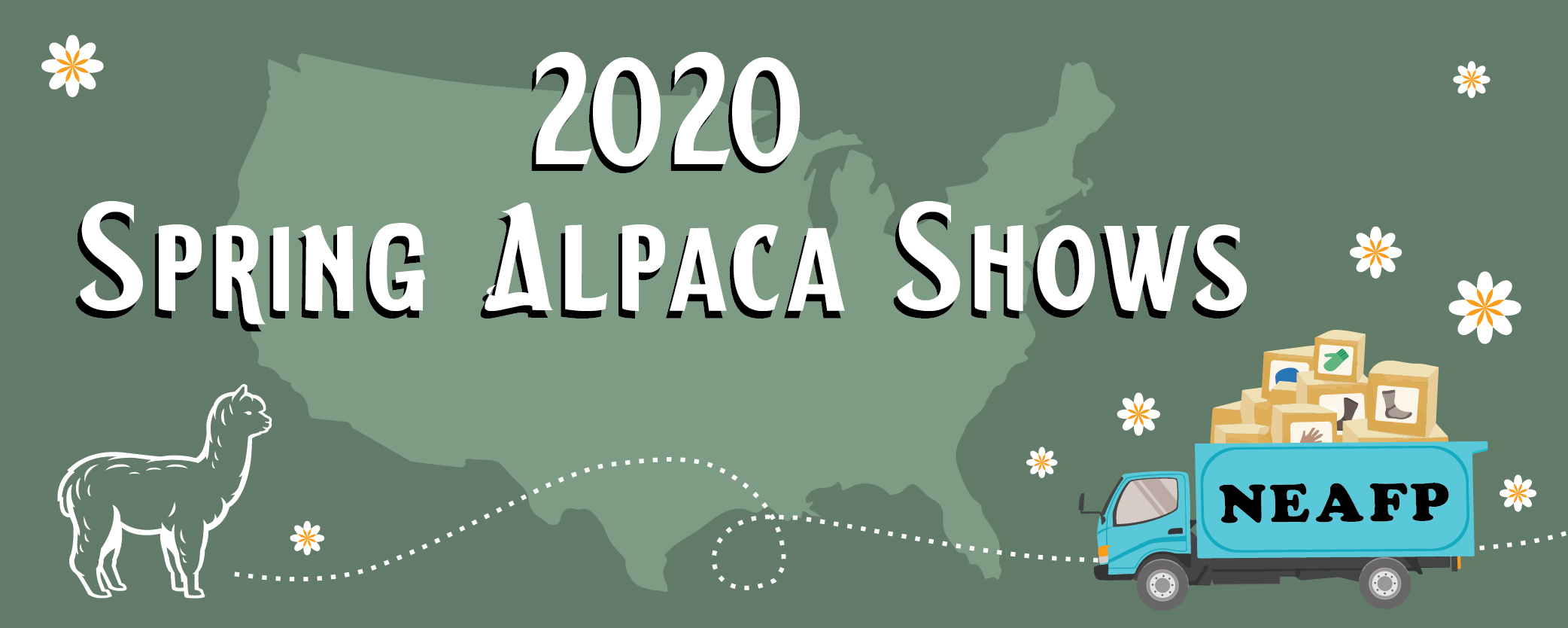
Each year NEAFP participates as a vendor in many alpaca shows scattered across the country. We are happy to haul your fiber back to our mill for free (RSVP with the links below!) We also deliver orders for free to shows we are attending as a vendor, just place your order at least a week before the event and save on shipping costs both ways!
Please note that Third Grade Fiber is NOT Eligible for Event Collections.
Carolina Alpaca Celebration
Fiber Collection RSVP HERE
February 15th - 16th, 2020
Concord, NC
PAOBA Breeder's Showcase
Fiber Collection RSVP HERE
March 20 - 22nd, 2020
Centre Hall, PA
North American Alpaca Show - Fiber Collection RSVP HERE
April 4th-5th, 2020
Springfield, MA
MAPACA Jubilee
Fiber Collection RSVP HERE
April 24th - 26th, 2020
Harrisburg, PA
show website
Stay tuned as more shows are added throughout the year!
Article: Harnessing Holiday Sales Momentum in the New Year
Alpaca farm stores across the nation report that 2019 was a record year for sales of alpaca goods, and it’s no surprise that the holidays were a huge sales driver. However, many business owners find that sales fall flat after the holiday season. The fall festivals and Christmas markets that are a touchstone of the season certainly make it easier to find customers and connect them to the gifts they are searching for. Though it may require some extra legwork, the diligent alpaca farmer can find ways to harness their holiday sales momentum into the New Year.
| Remember What You're Selling |
Unlike some holiday gifts, alpaca products go hand-in-hand with cold weather. Don’t forget that winter only officially began on December 21st! It will be a long winter, and it’s bound to get colder and snowier. Alpaca socks, gloves, and hats, among other products, are naturally soft, strong and warm, making them great winter insulators! Warm, cozy alpaca clothing and accessories are a no brainer, but cold winters spent inside are also great times to knit. Alpaca yarns are a great item to market during the winter to your crafty customers.
Communicating the benefits of alpaca with potential customers can make or break a sale. Perhaps your customer received a pair of new snow boots for Christmas. Make their boots last longer and feel even warmer with a pair of alpaca boot inserts, by stressing alpaca’s moisture wicking and odor resistant properties!

Using clear marketing collateral at your farm or market booth can really help communicate the benefits of alpaca to your customer base. You can find a number of such posters in the Marketing & Collateral section of our website (which can be viewed when signed into your shopping account).
| Market to the "New Year" Mentality |

“New Year, New You!” so the saying goes! Even before the holiday decor comes down, stores begin stocking up on cleaning products, exercise equipment, and health foods. For many, the New Year is synonymous with a lifestyle change, and resolutions mean a fresh start focusing on self-care. All-natural alpaca fiber is a healthy choice for clothing and accessories, as it’s naturally hypo-allergenic and odor resistant without the use of treatments and finishes. U.S. grown and made alpaca is renewable, sustainable, and beneficial for the climate at every stage of its life cycle. This makes it a perfect fit for customers hoping to to support slow, feel-good fashion and local small businesses as part of an overall lifestyle change. As an alpaca farmer and local business owner, it's your job to educate your customers on the power of their dollar and the meaningful story behind U.S. Grown, U.S. Made Alpaca.
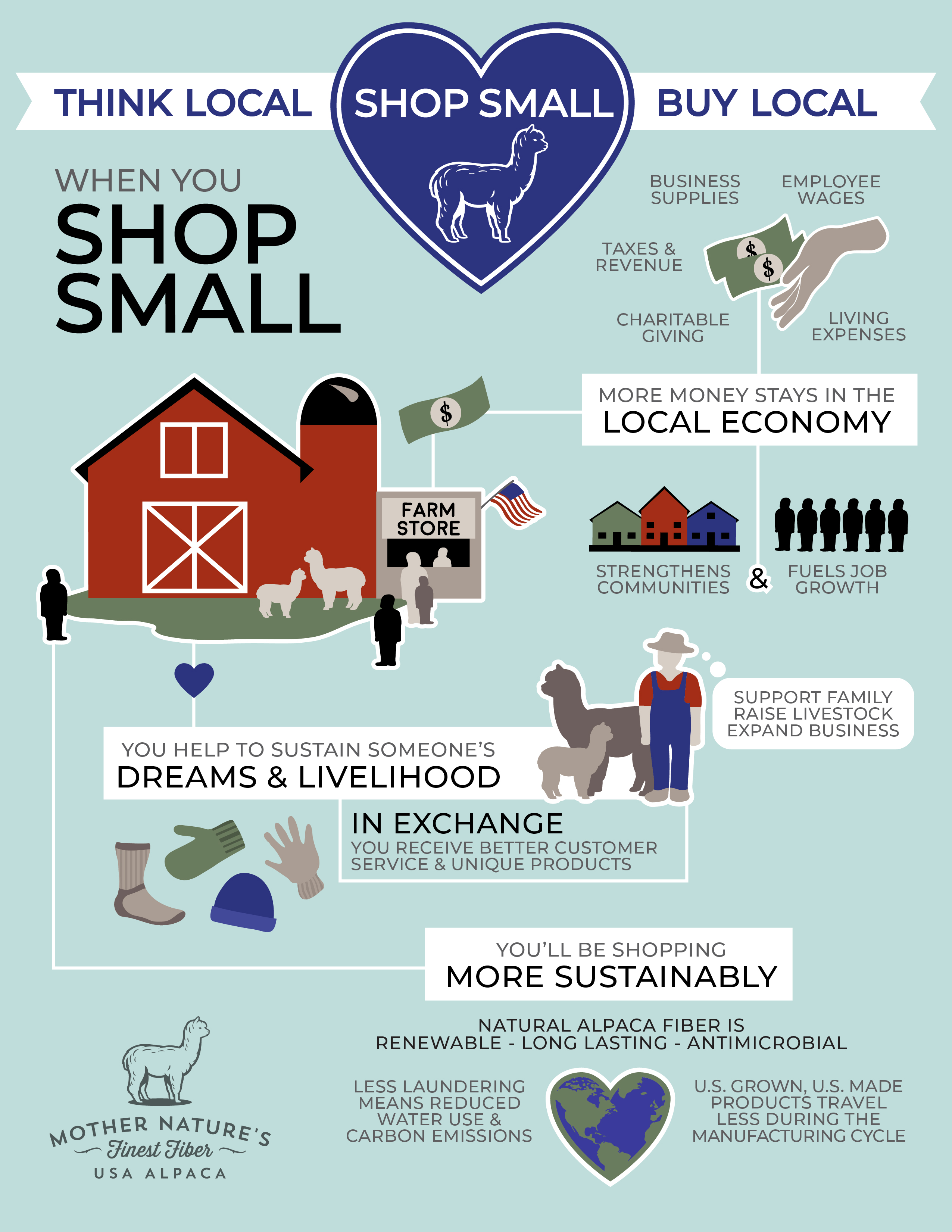
| Reward Your Biggest Fans |

For those who have received cash under the tree or in their stockings, a pair of alpaca socks could be the perfect gift. Incentivize post-holiday sales by offering a promotion to your customers. Even the most shopped-out shopper may not be able to resist a good deal! Utilize your growing email list and social media fanbase to market directly to your best customers and supporters. This could be through offering free shipping, a storewide sale, or a free gift with purchase. Even better? Take account of your inventory and discount your slower moving products with your own New Year's clean sweep. Not only will your customers appreciate the markdown, but you'll be able to make room in your inventory for the essentials in the upcoming year.
| Plan for Upcoming Holidays |

Now is the time to start planning for smaller holidays like Valentine's Day, and even events like the Superbowl. The National Retail Federation found that in 2019, planned celebrations of Valentine’s Day were down, but spending was up. If trends for 2020 compare to those of 2019, an increasing number of shoppers will search for experiential gifts, rather than a bouquet of flowers or boxes of candy. As we noted in a previous article, farmers have found agritourism to be widely successful source of income. Your farm could host a one-on-one meeting with an alpaca on Valentine's Day, or be the backdrop for a wine tasting, paint night, or other romantic event.
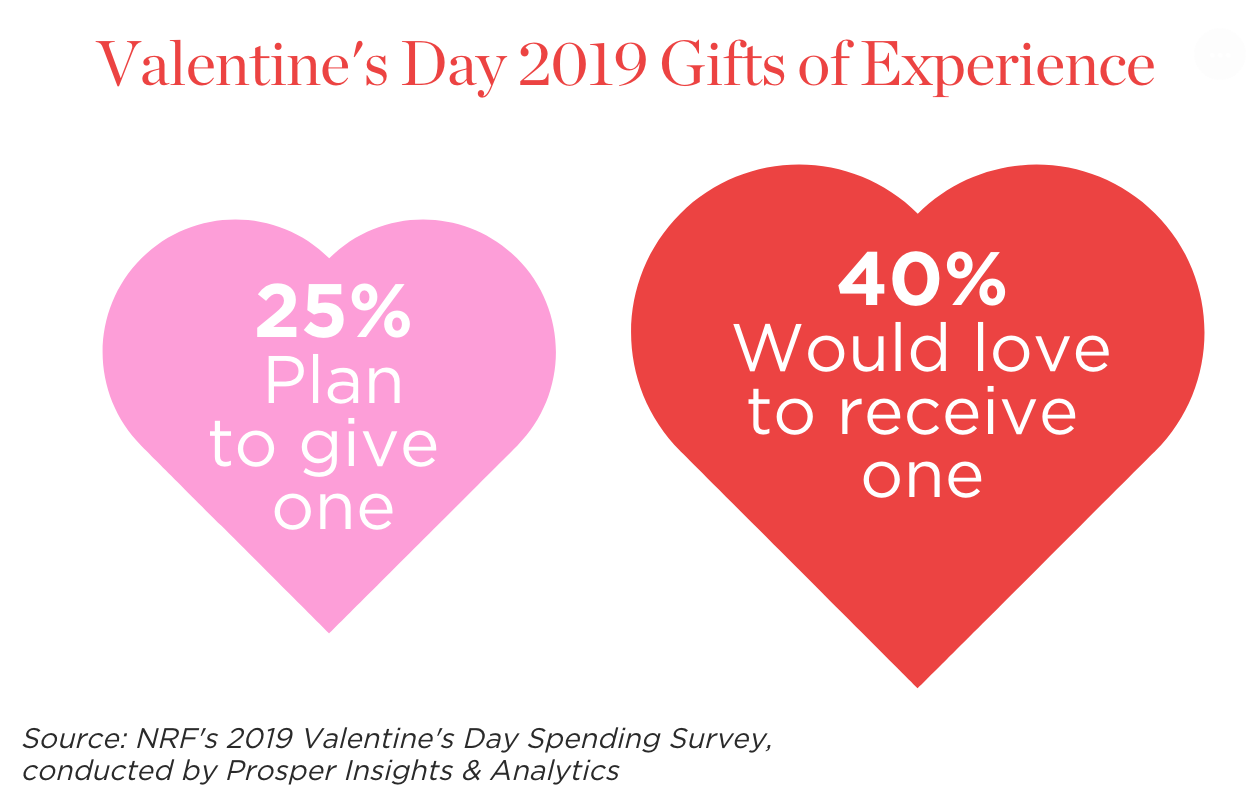
| Reflect on 2019 and Prepare for the New Year |

Even though sales may be down in comparison to November or December, it’s not the time to go silent. Be sure to continue marketing your products on social media, which is reportedly surpassing email marketing to become the most powerful marketing channel available. If possible, follow up and thank holiday shoppers, and ask them for a review on social media! Positive reviews can help drive business in your slow season, and you may simultaneously remind previous customers that they need to reorder something from you in the new year!
Remember, a dip in sales is to be expected after the holiday season, especially as the NRF reports that holiday sales represent about 20-30% of annual sales for most retailers. Use your downtime to plan for the following year. This may be through budgeting, or by creating new content for your social media page with the help of a social media calendar.
Consider what did well for you in the previous year, and what you could improve on. Think about the pop-up markets and events you attended - how were their sales compared to previous years? Make a list of pros and cons of each and start planning your calendar for the upcoming show season. Were there certain products that did well, or months that sales fell flat? If possible, find a way to highlight what you did well and troubleshoot what went wrong before things pick up again next fall... and don't forget to congratulate yourself for the job well done in 2019!
Cheers to 2020!
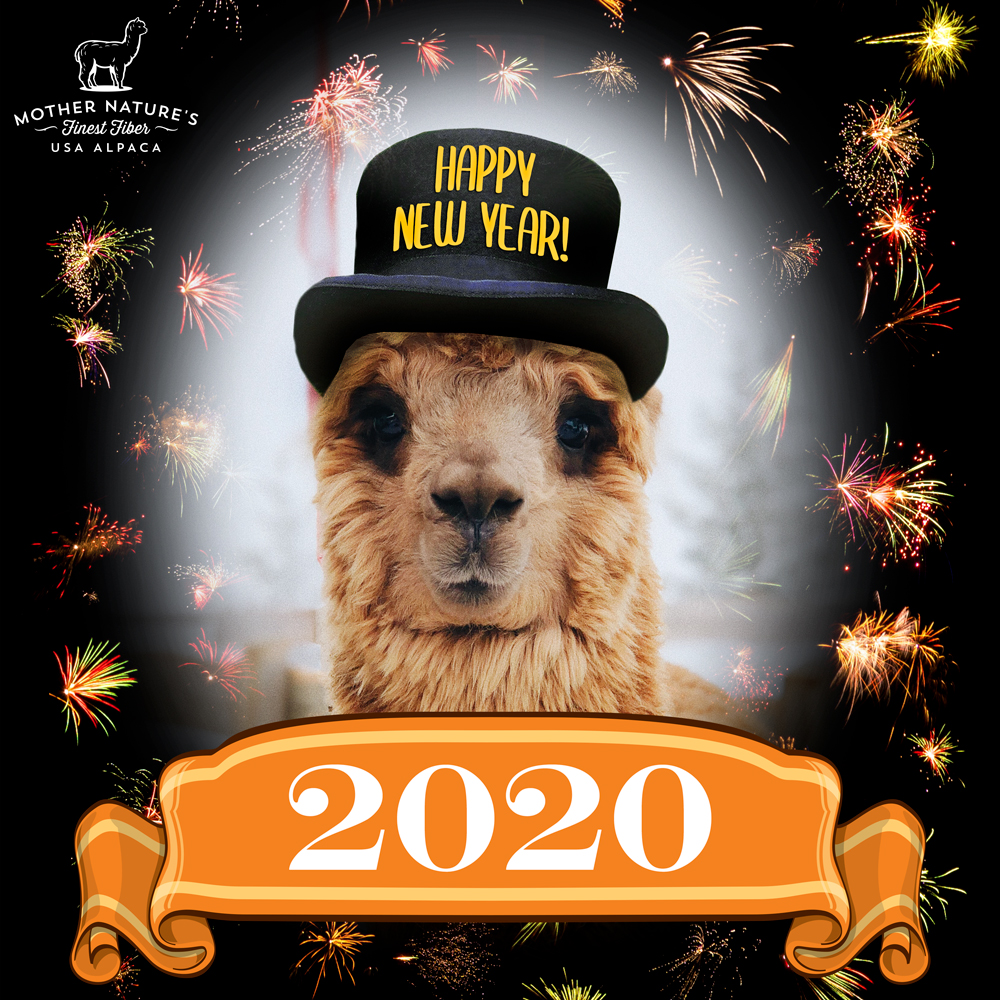
We hope that these Business Resource Blog Posts have been helpful. Is there a topic you'd like us to cover in a future post? Write to us at support@neafp.com
NEW Downloadable Content: January Coloring Page!
Although the holidays are over... the cold and snow are here to stay!
The alpacas are itching to get out and play. Even if there's no snow on the ground, the January coloring page will give you the chance to play by putting the finishing touches on the alpaca's snowman!

Winter markets and open houses continue into the new year!... Hoping to entertain your youngest alpaca fans?
We've got you covered with a free downloadable coloring page!
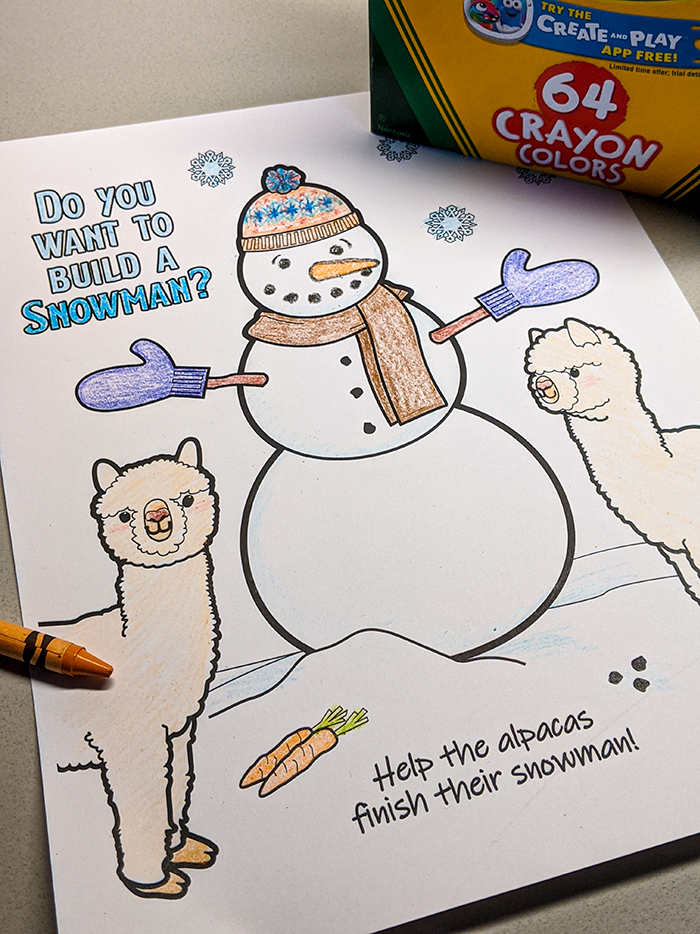
Find it here on Facebook, or download a full-size, printer-friendly version at the bottom of this article!
Download the printer-friendly files here!
PDF Download - January Alpaca Coloring Page
High Resolution JPG Download - January Alpaca Coloring Page
Have an idea for a future graphic? Email us your ideas to support@neafp.com
U.S. Alpaca Holiday Gift Guide
Still Searching for the Perfect Holiday Gift?
If you're like us, you might have put off some (or all) of your holiday shopping. We've put together a gift guide to make giving a little more joyous! Take a look at these top picks for all the people on your list.
All these U.S. Alpaca items are available at a farm store near you, just use our
store locator here: http://bit.ly/alpacafarmstores

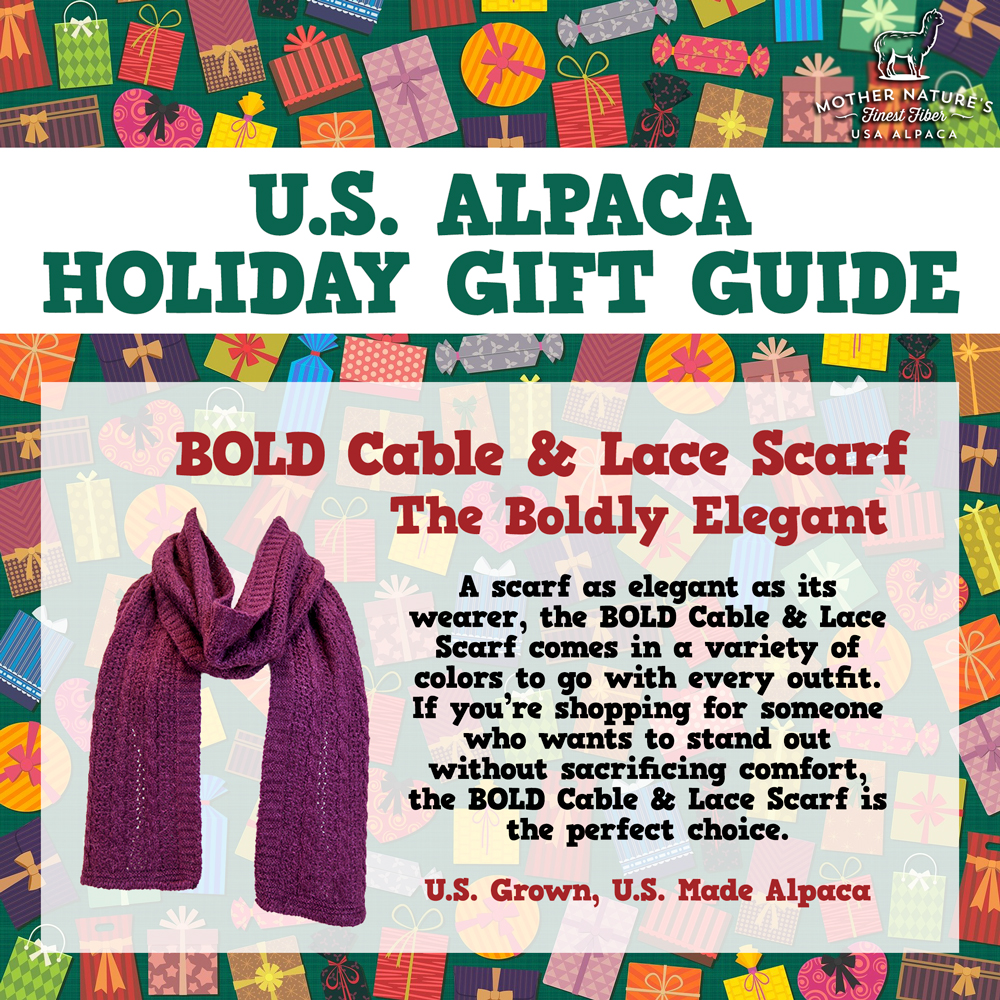

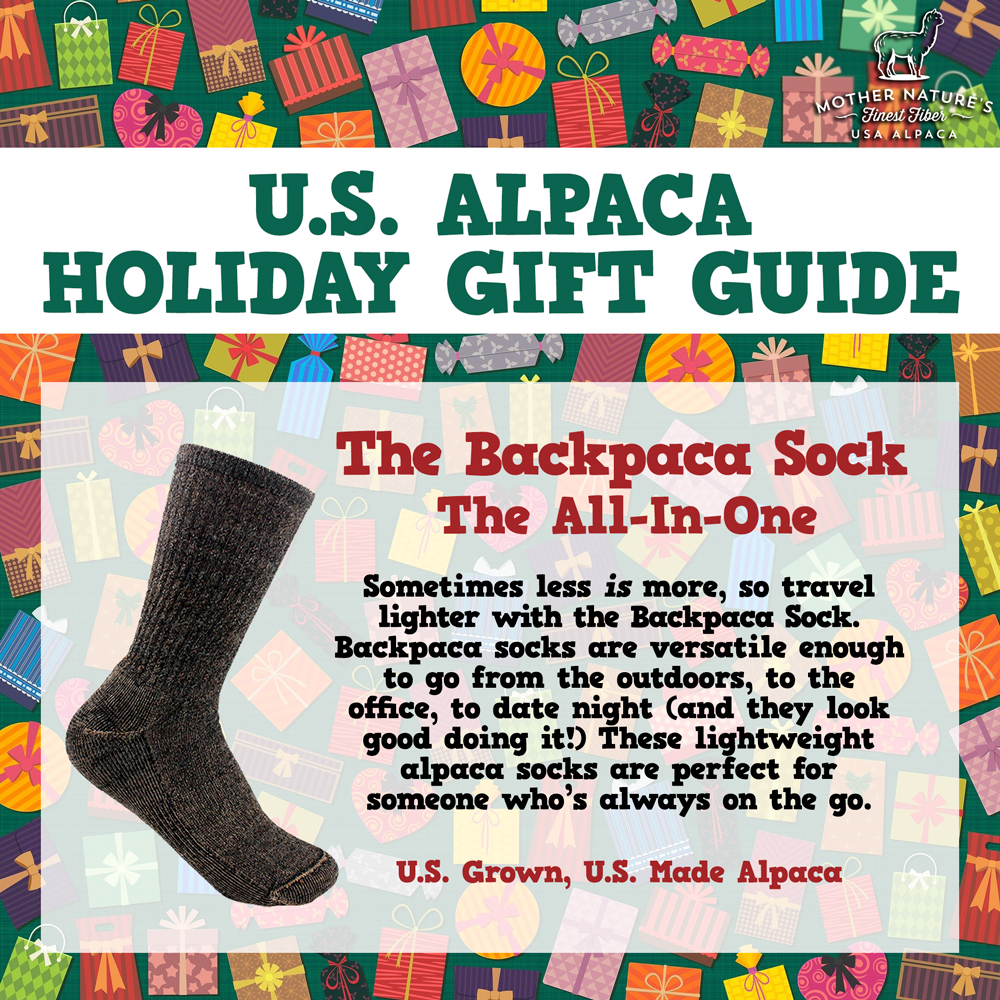


NEAFP's Holiday Shipping Time Tables
Need it for the Holidays?
Believe it or not 2019 is winding down and the Holidays are just around the corner.
Here is all the most important info needed to plan ahead for those last minute orders!
NEAFP will be closed for our annual Holiday break Tuesday Dec. 24th through Thursday December 26th.
We will be back to work Friday December 27th.
Our last shipping day before our Holiday break is Monday December 23rd!
Any order that needs to ship out that day needs to be placed by 8am Monday morning to ensure shipment.
Through the holiday season, we recommend choosing UPS Ground or better for all your time sensitive orders. USPS starts to slow down in certain parts of the country and timely delivery is not guaranteed. Watch major weather patterns / snow storms as these may effect delivery times.
NEW Downloadable Content: Christmas Coloring Page!
We have officially entered the holiday season...
Between sending off socks, hats, and gloves to good little boys and girls, the NEAFP elves were busy creating the December coloring page!
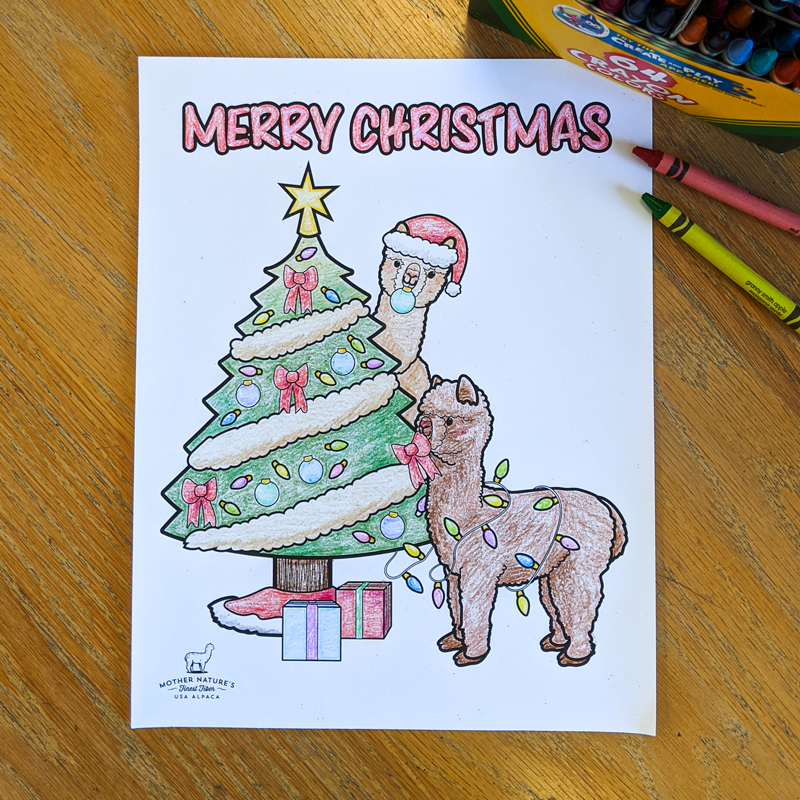
You're sure to be hosting open houses and participating in holiday markets, fairs, and festivals this month... Hoping to entertain your youngest alpaca fans?
We've got you covered with a free downloadable coloring page!

Find it here on Facebook, or download a full-size, printer-friendly version at the bottom of this article!
Download the printer-friendly files here!
PDF Download - Christmas Alpaca Coloring Page
High Resolution JPG Download - Christmas Alpaca Coloring Page
Have an idea for a future graphic? Email us your ideas to support@neafp.com
Thanksgiving Shipping Schedule
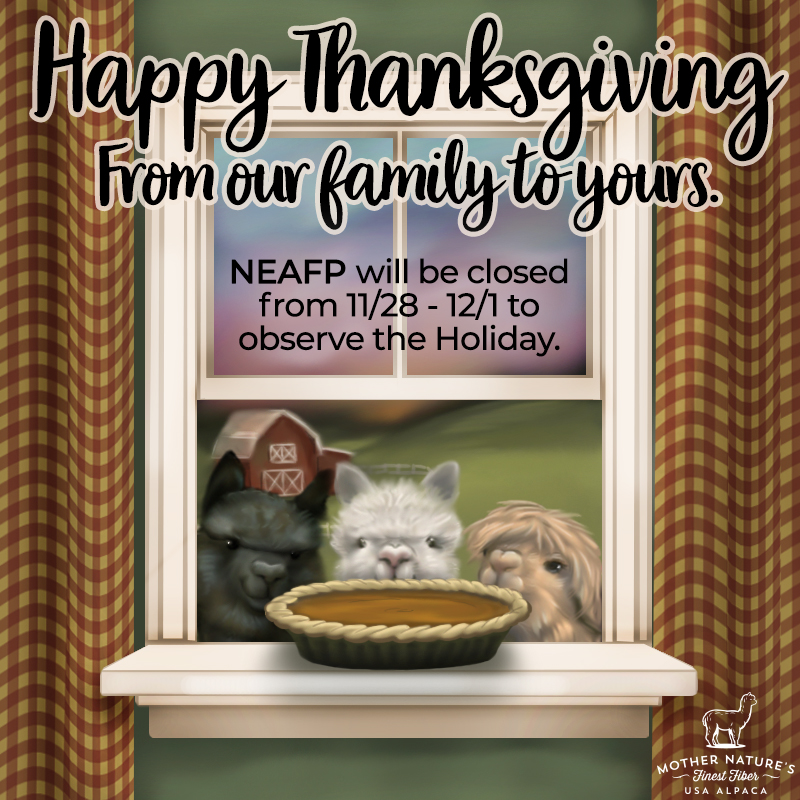
NEAFP's mill and office will be closed Thursday the 28th and Friday the 29th for the Thanksgiving Holiday.
All orders placed by the end of the day on Tuesday the 26th will ship Wednesday before we close.
Any order placed after then will ship when we return to the mill starting Monday December 2nd.
Thank you and we hope you all have a Happy Thanksgiving!
Our 2019 U.S. Alpaca Holiday Ornament is here!

2019 Limited Edition
U.S. Alpaca Holiday Ornament
We are excited to release our 2019 U.S. Alpaca Holiday Ornament! Designed, Cut and Engraved in house by NEAFP, these ornaments are great little keepsakes to share with your customers during the holiday season.
2019 was truly the year of U.S. Alpaca so we wanted to make the alpaca take center stage in this unique one of a kind snowflake designed holiday ornament.
The snowflake patterned ornament is cut from sustainably sourced 1/4" Bamboo hardwood with the year engraved below a white acrylic alpaca inlaid into the bamboo.
We are producing them in a limited small run, once they are sold out they are gone for the 2019 holiday season! Our 2018 U.S. Alpaca ornament sold out within 4 weeks of being announced!

The 2019 U.S. Alpaca Holiday Ornament is made from sustainable Bamboo hardwood, left in its natural unfinished beauty. This ornament measures approximately 4” wide by 4” high.

Get one for yourself, a few as stocking stuffers,
or take advantage of quantity discounts and offer them to your biggest alpaca loving fans!
Available now in our Gift and Accessories category!
NEW Downloadable Content: Thanksgiving Coloring Page!
We loved seeing completed Halloween coloring pages from your latest events, so we're following up with a Thanksgiving coloring page for the month of November!
You're sure to be hosting open houses and participating in holiday markets, fairs, and festivals this month... Hoping to entertain your youngest alpaca fans?
We've got you covered with a free downloadable coloring page!
Find it here on Facebook, or download a full-size, printer-friendly version at the bottom of this article!
Download the printer-friendly files here!
PDF Download - Thanksgiving Alpaca Coloring Page
High Resolution JPG Download - Thanksgiving Alpaca Coloring Page
Have an idea for a future graphic? Email us your ideas to support@neafp.com
Free Resources: Support your Local Alpaca Farm on Small Business Saturday!
With Black Friday and Cyber Monday looming, we’ve all been inundated with marketing for the hottest deals and steals of the season. Let’s face it: as an alpaca farmer, your morning chores may prevent you from standing in line at 3am, and while the internet has allowed you to reach new customers, local community support has always been the key to your success. There’s no need to say “Bah Humbug,” however, as Small Business Saturday is the perfect opportunity to capitalize on the after-Thanksgiving shopping rush.
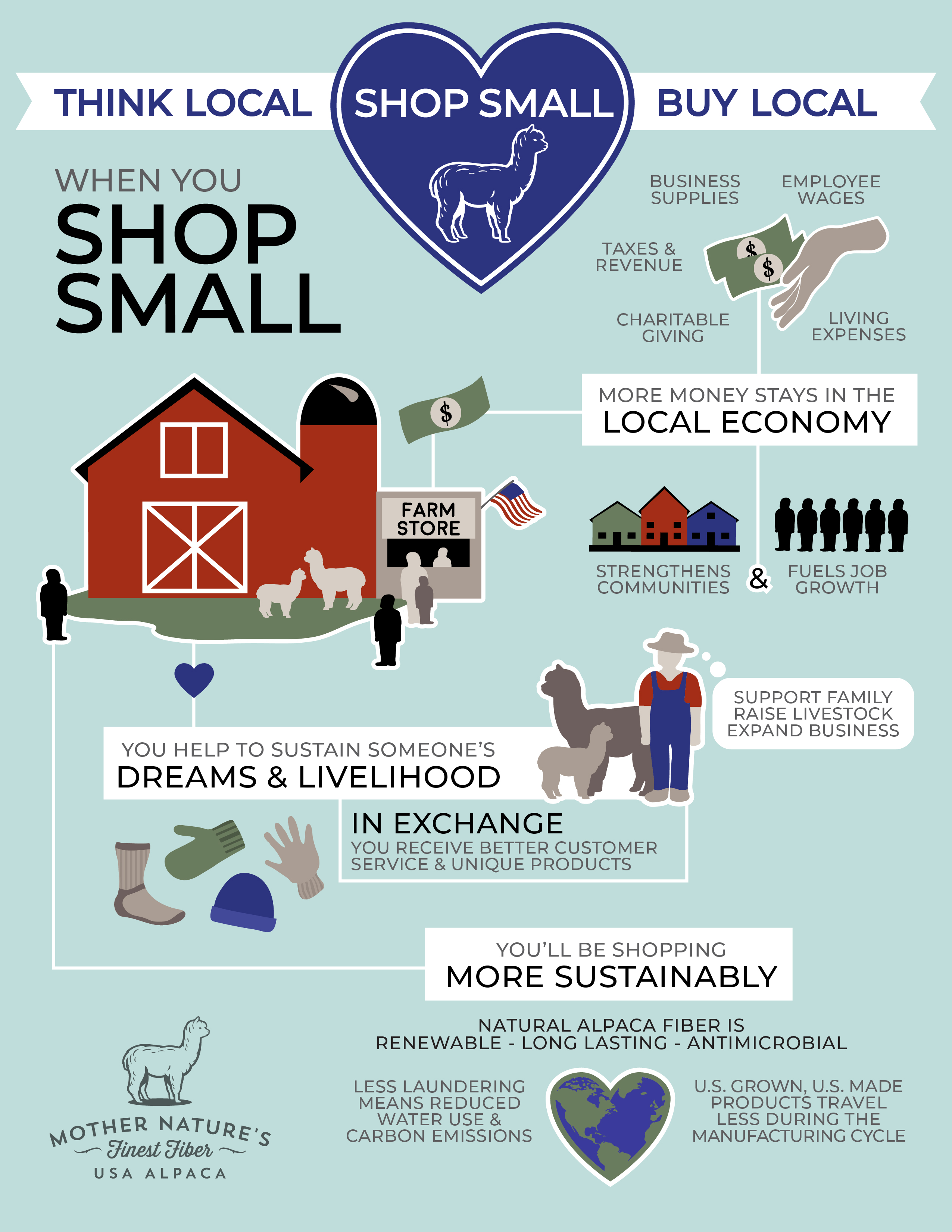
Small Business Saturday began in 2010 as a joint venture between American Express and a number of other parties, though it has since evolved and taken on a life of its own. The shopping holiday, which falls on the last Saturday of November, is now in its 10th year. Held this year on November 30th, Small Business Saturday urges consumers to shop at locally owned small and independent businesses.
Last year, the holiday drove record sales to small businesses, while also illustrating the joys of shopping small, as “96% of consumers who reported shopping on Small Business Saturday said the day makes them want to Shop Small all year long, not just during the holiday season.”1
Why Does Small Business Saturday Matter?
- In 2018, U.S. consumers reported spending a record high of an estimated $17.8 billion at independent retailers and restaurants on Small Business Saturday.
- Small businesses comprise 99.9% of all United States businesses.
- Small businesses employ over 58.9 million people in the U.S.A.
- Small businesses invest more of their revenue into the local economy, community, and employees, and are more likely to be socially and civically engaged in the community.
- Locally owned businesses are often more invested in the financial wellbeing of their employees, while shopping at big box companies drives income inequality.2
As an alpaca farmer, you are already in your prime sales season, so seize the day and host an event, join a market, or have an open house on Small Business Saturday! Be sure to let your customers know the benefits of shopping local!
Free Resources:
 |
Click Here --> Downloadable Shop Small Alpaca Banner Click Here --> Downloadable Shop Small Alpaca Infographic Click Here --> Downloadable Shop Small Alpaca Logo |
The American Express Website has some free resources available for businesses to gear up for Small Business Saturday:
Customizable Marketing Materials: https://www.americanexpress.com/us/small-business/shop-small/studio?intlink=us-mer-sbrc-sbs-studio
Shop Small Map: https://merchant-global.americanexpress.com/login/public-profile
1,2. Statistics from https://www.americanexpress.com/us/small-business/shop-small/about?linknav=us-loy-homepage-learnmore & https://www.sba.gov/sites/default/files/advocacy/2018-Small-Business-Profiles-US.pdf
BOLD Cable Beanie is new and improved!
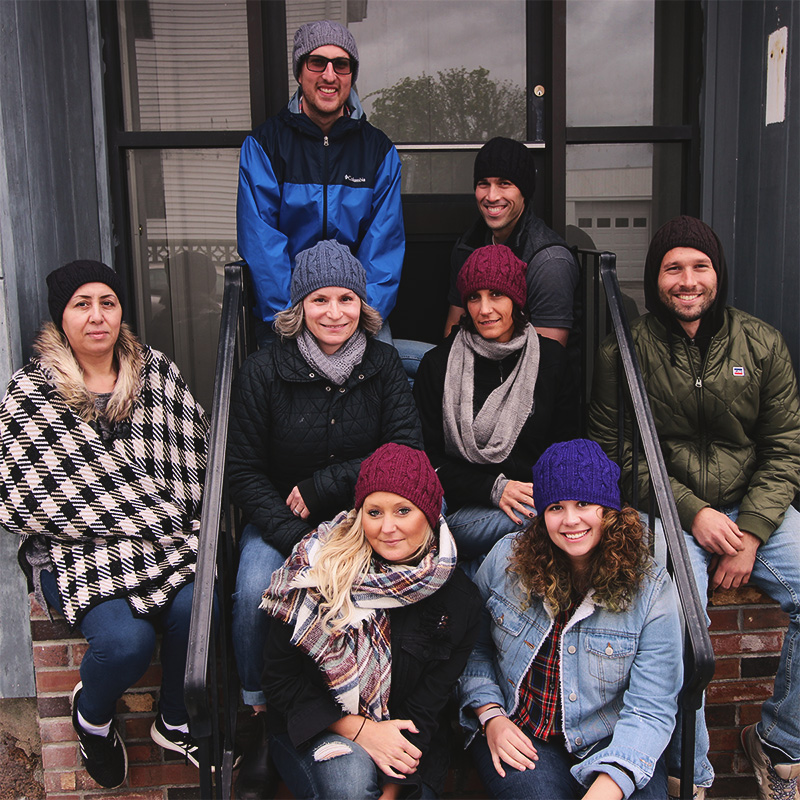
**2019 Update**
This classic alpaca hat just got better. We've completely overhauled the design of the Cable Knit Beanie to make it softer, warmer, and more comfortable to wear. The fit has been improved so it wears like a typical beanie style hat and an inner headband lining has been added. The lining helps block the wind and keep your ears and neck warm while the top of the hat still breaths so you don't over heat. Soft, warm, and stylish!

Available in Black, Denim Blue, Mulberry, Slate Grey, & Royal Purple
Article: Tools and Topics for Implementing Healthy Soil Agriculture

NEW Downloadable Content: Halloween Coloring Page!
As the weather gets cooler, you're sure to be hosting open houses and participating in markets, fairs, and festivals. Hoping to entertain your youngest alpaca fans?
We've got you covered with a free downloadable coloring page!
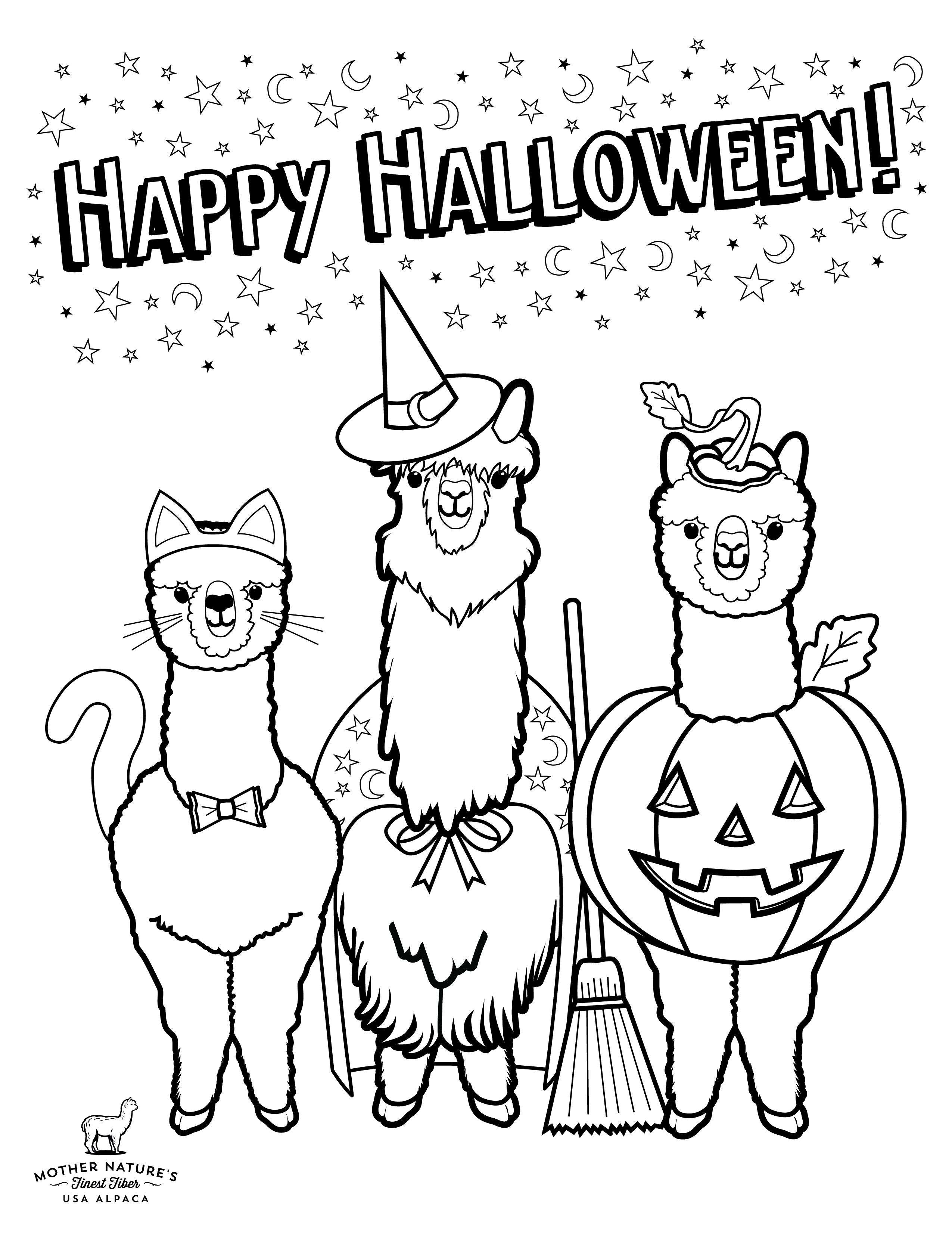
Find it here on Facebook, or download a full-size, printer-friendly version at the bottom of this article!
Download the printer-friendly files here!
PDF Download - Halloween Alpaca Coloring Page
High Resolution JPG Download - Halloween Alpaca Coloring Page
Have an idea for a future graphic? Email us your ideas to support@neafp.com
Article: Successful Social Media Marketing for Alpaca Farms
Do you have a Facebook or Instagram page for your farm or farm store? If you don't, you could be missing out on new avenues to sell your products! Perhaps you already have one but you aren't getting the traffic you were hoping for. It may seem daunting to manage multiple social media pages on top of the work you do as a farmer on a daily basis, so we've put together some tips to help you be more successful!
| Start with a Goal or Plan in Mind |
|
As you begin exploring social media marketing, take a moment to decide what you want to gain out of the experience. Your business pages on Facebook, Instagram, and other platforms can serve you and your customers in a number of capacities, so it is easy to get overwhelmed by the possibilities. You may decide to:
|
 |
| Understand your Audience |
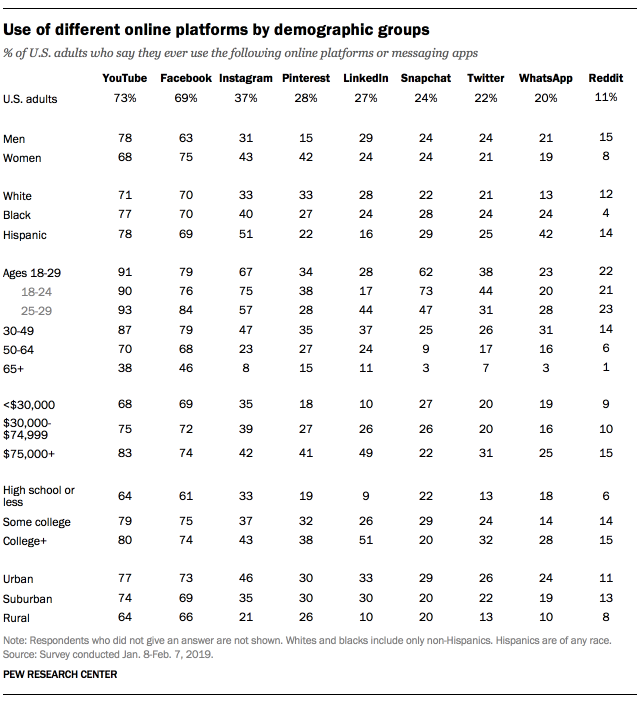
There are many active social media platforms, but which one will get you the response you’re looking for? A 2019 Pew Survey of US Adults points to YouTube and Facebook being the most popular social media platforms, but that doesn't mean you should discount the others. Take into account factors like the intended age and gender of your prospective customers. Facebook is consistently popular with both younger and older adults, while others like Instagram and Snapchat attract young adults almost exclusively. On the other hand, Pinterest users are more than 3 times more likely to be women.
Take into consideration the intended purpose of each platform as well. While it may behoove you to create a personal LinkedIn page as a business professional, you will be hard pressed to find customers there! Instagram and Pinterest tend to focus on the visual while Twitter is textual. Knowing the difference between each platform can help you cater your content to your intended audiences.
Be sure to utilize the various analytics pages available to monitor your page performance. Facebook and Instagram analytics provide useful information, including when people visiti your page or posts, what is most popular, and who your audience is based on their age and location. Use this information to hone your social media marketing skills!
| Be Responsive | |
| Think of social media as another avenue for conversation. Customers will use it to chat with you, ask questions, and review your products and services. Become an active participant by "liking" comments, responding to questions in a timely fashion, and regularly posting updates about your business. You may receive negative comments or critiques regarding your services, products, or animals. If this happens, always keep a level head to prevent escalating the issue. It may be helpful to think of possible responses ahead of time. For example, if a social media follower accuses you of cruelty for shearing your animals, have a thoughtful response ready to explain why alpacas need to be sheared on an annual basis. |
 |
| Rely on Visuals |
Social media marketers find that they rely heavily on visual media when reaching out to their customers. Data on visual content marketing from the past few years illustrates that captivating visual media is necessary for high levels of customer engagement with your pages.
There are a number of ways to incorporate video and images into your social media marketing. Original content in the form of videos, shared content like related graphics and memes, as well as product, animal, and lifestyle photography are all great ways to go visual. Videos should be short enough to keep the attention of your viewers and photographs and images should be at a high enough resolution to be viewable!
Don't think that visuals are that important? They certainly are if you're hoping to create a paid ad for Facebook. If you plan to promote your business through a paid Facebook News Feed ad, only 20% of the image can have text on it, or it will not pass through Facebook's filters!
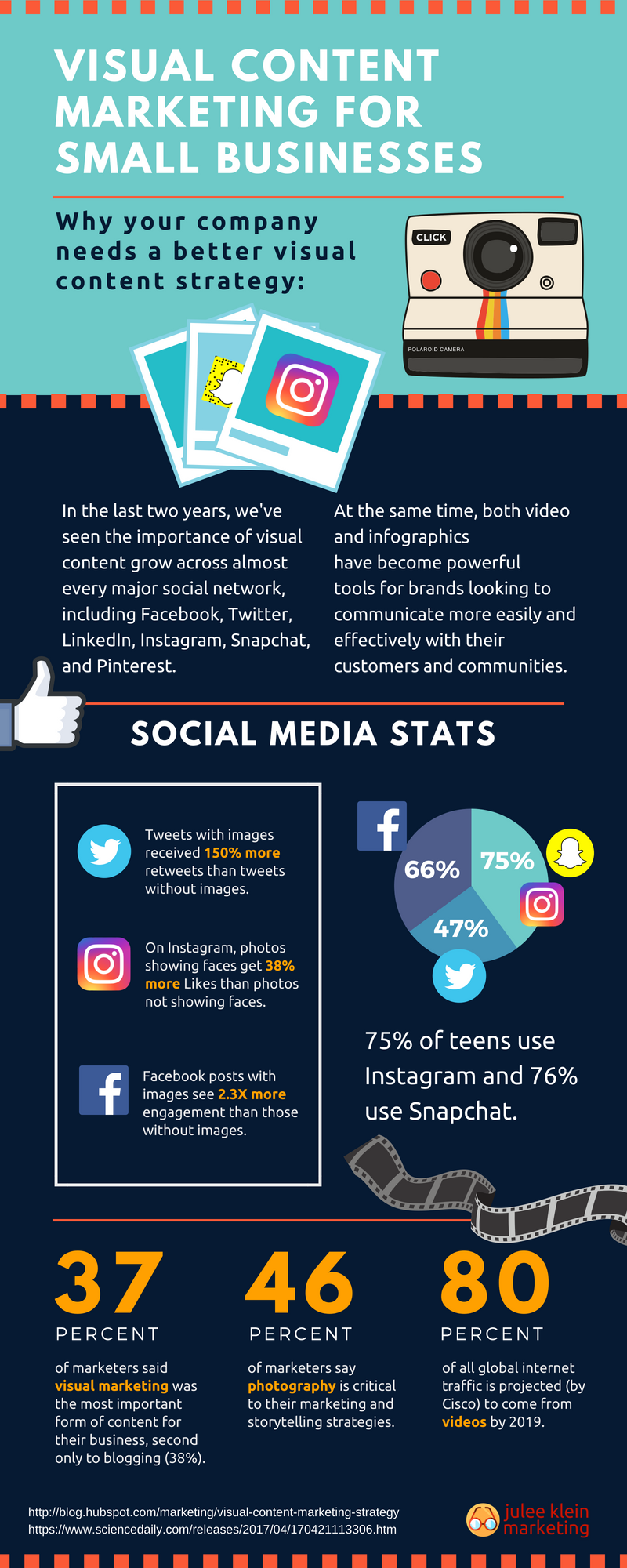
| Stay on Schedule |
| Timing is important when it comes to social media for many reasons. Regularly posting keeps your followers interested and engaged, while platforms like Facebook have a number of built in features like post scheduling and event hosting that can help you reach your intended audiences. Here are a few ways to stay organized. | |
|
1. Create a social media calendar to keep track of when and how often you should post to social media. Monday: Post a candid barn photo or video of an alpaca Wednesdays: Post a photo of one of your products and a link to where it can be purchased. Friday: Remind your followers where you'll be selling products that weekend (ex: "Stop by the farm tomorrow from 10am-2pm!") 2. Schedule Posts in Advance during Peak Viewing Times Did you know that people tend to check social media at certain times, and it differs between platforms? Different businesses have greater success depending on the time of day as evidenced by this chart on prime Instagram posting times. Hootsuite found in their research that the best time to post to Facebook for Business to Consumer brands is 12 p.m. EST on Monday, Tuesday, or Wednesday. Take advantage of Facebook's ability to schedule posts in advance through Publishing Tools. That way, you can make sure your content gets out there and better yet-- you don't forget to post it on your busiest days! |
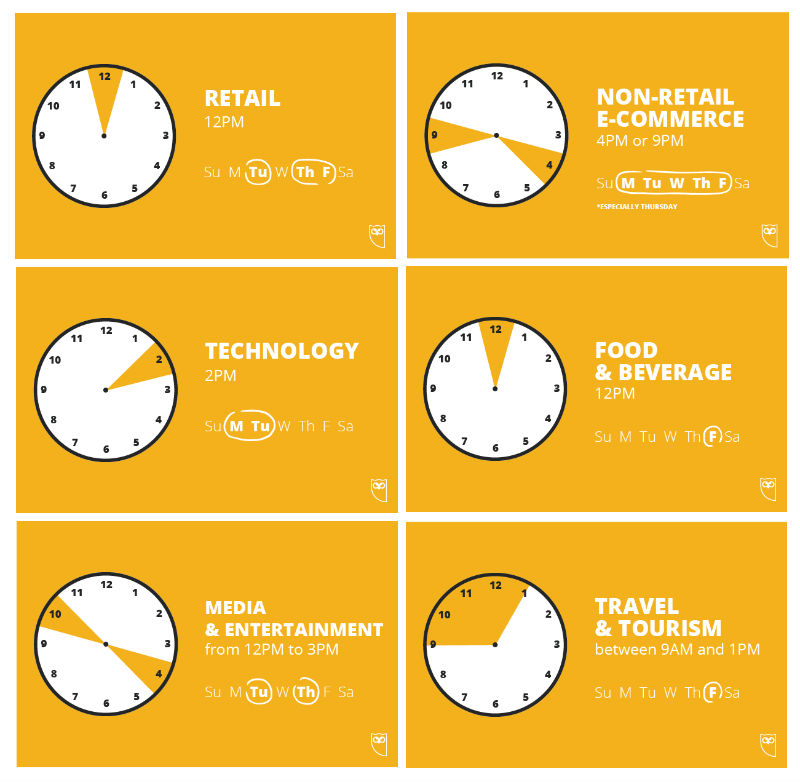 |
|
3. Schedule and Share Facebook Events If you're planning a farm event, be sure to create a Facebook event to organize all the pertinent information that an event-goer, potential farm visitor, or shopper may need. This includes a clear event title, thorough description, concrete location, and exact start and end times. The event can then be shared easily by both you and your followers. When setting up your event, use tags for relevant keywords. Interested parties may decide to stop by when searching for things to do using Facebook's calendar. |
|
Social media is constantly evolving, and while it can be hard to keep up, understanding the ways that these platforms can work for you can make your business more successful in the long run!
We hope that these Business Resource Blog Posts have been helpful. Is there a topic you'd like us to cover in a future post? Write to us at support@neafp.com
New Product: Textured Alpaca Slouch Beanie
Just in time for the cool weather,
introducing our Textured Slouch Beanie!
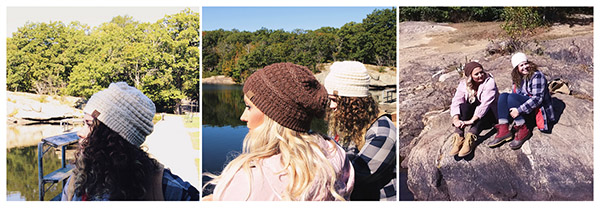
Adding on to the popularity of our Mountain Eve Alpaca Slouch Beanie released in 2018, we’ve created a unique textured beanie with the same slouchy silhouette.
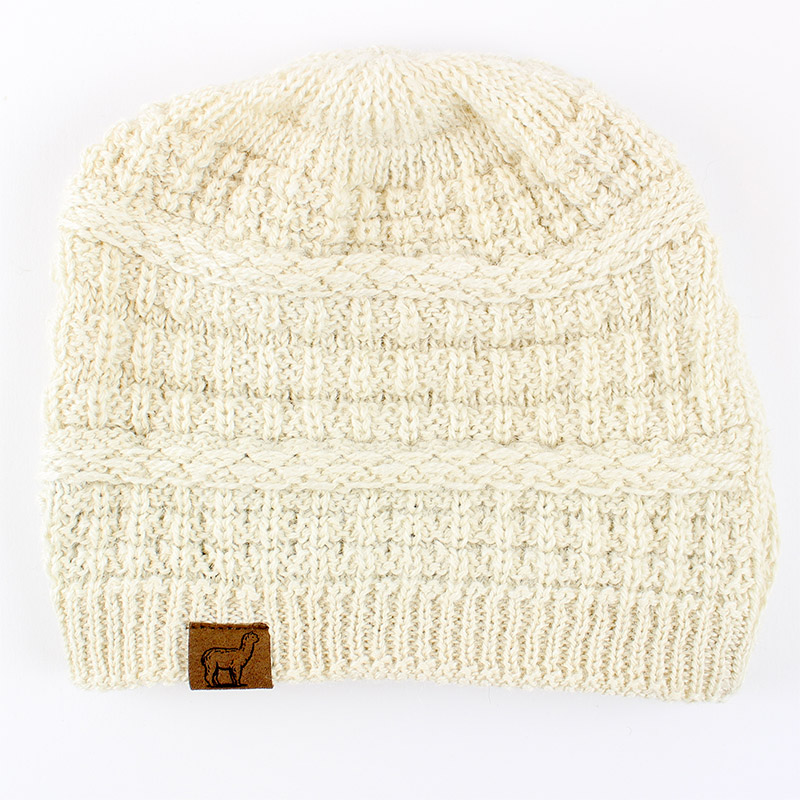
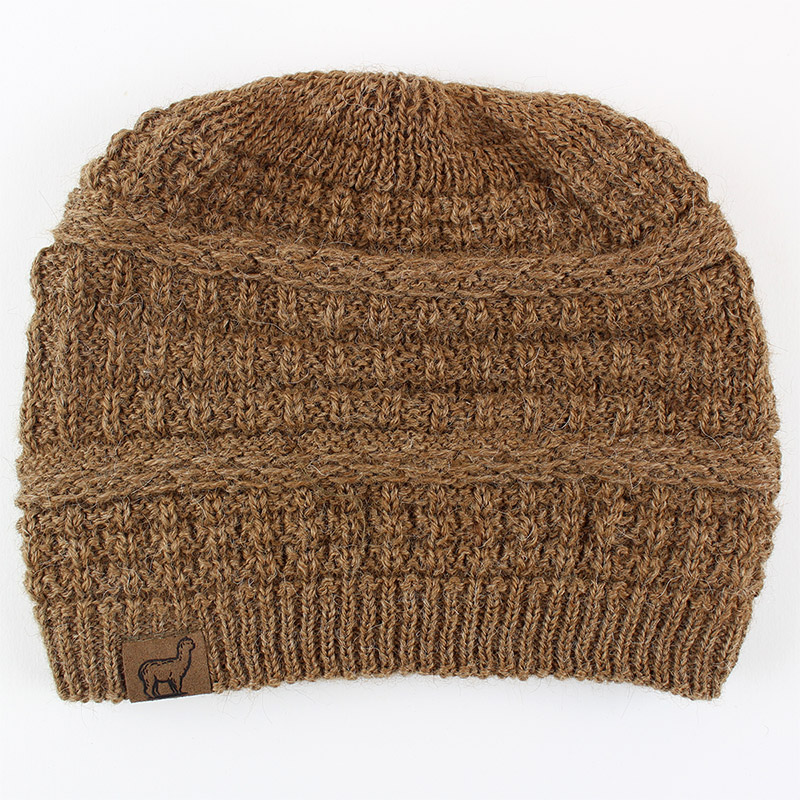
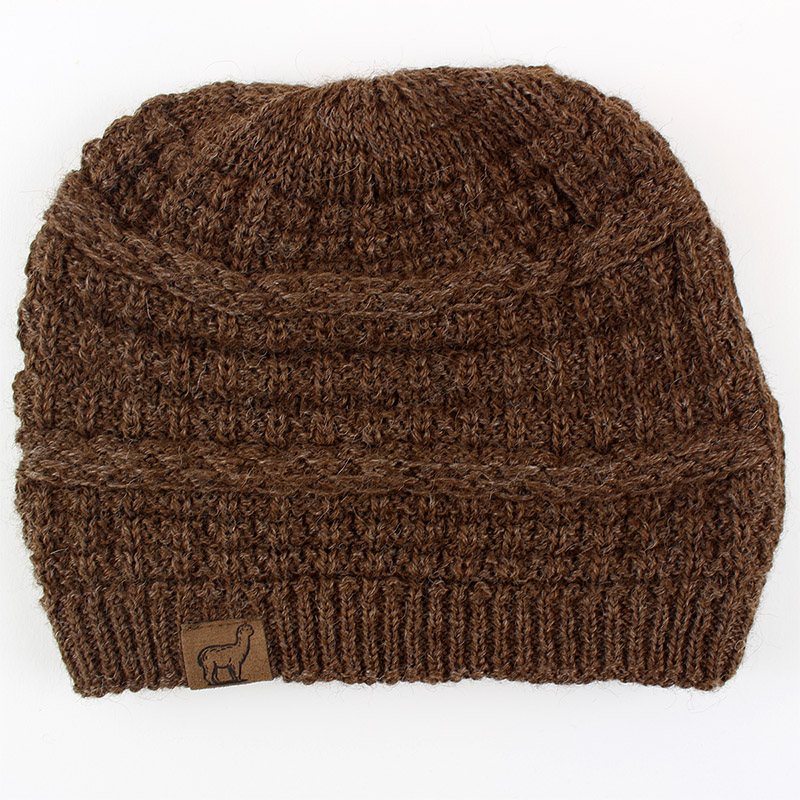
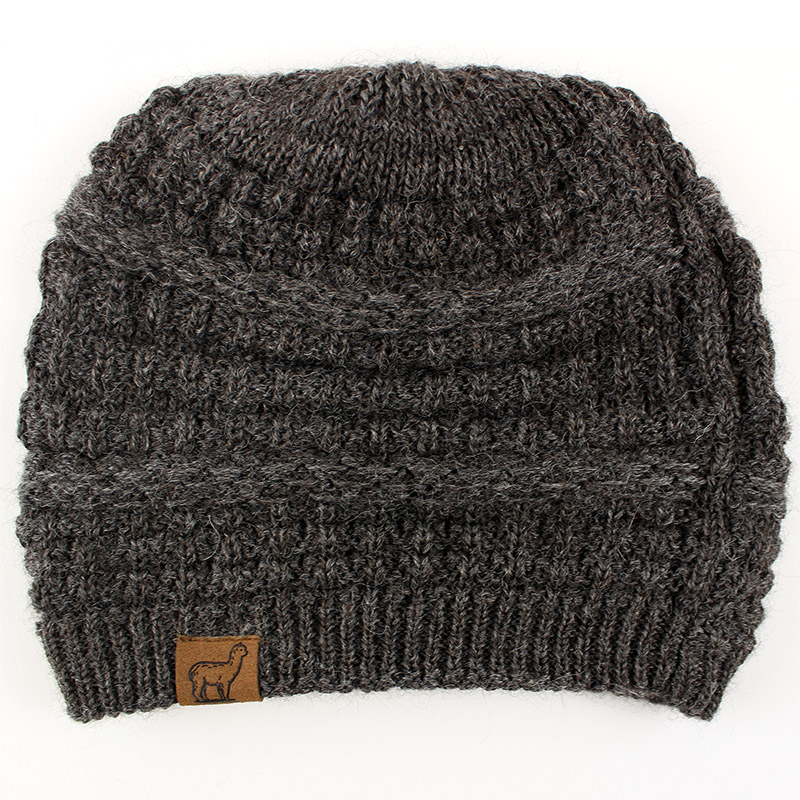
The Textured Slouch Alpaca Beanie is made from our softest U.S. Grown Alpaca and features all over contrasting rib & cable knitting using naturally colored alpaca yarn, which creates a subtle 3-Dimensional design.
The slouch beanie has that hip loose look on the top while still keeping your head warm in a wide range of conditions. The headband area features a microfleece lining, keeping the hat snug on your head and blocking wind on your forehead, ears, and neck. The top of the hat stays breathable so you feel comfortable while staying active in the great outdoors. This hat is finished with a faux suede sewn on tag, bringing the hat and the alpaca brand itself to new heights.
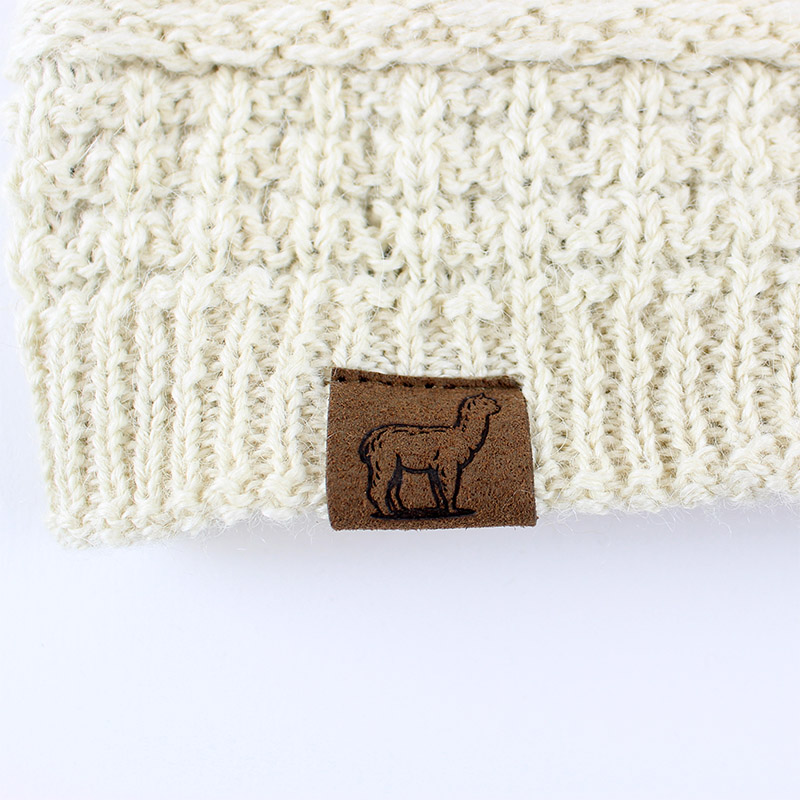
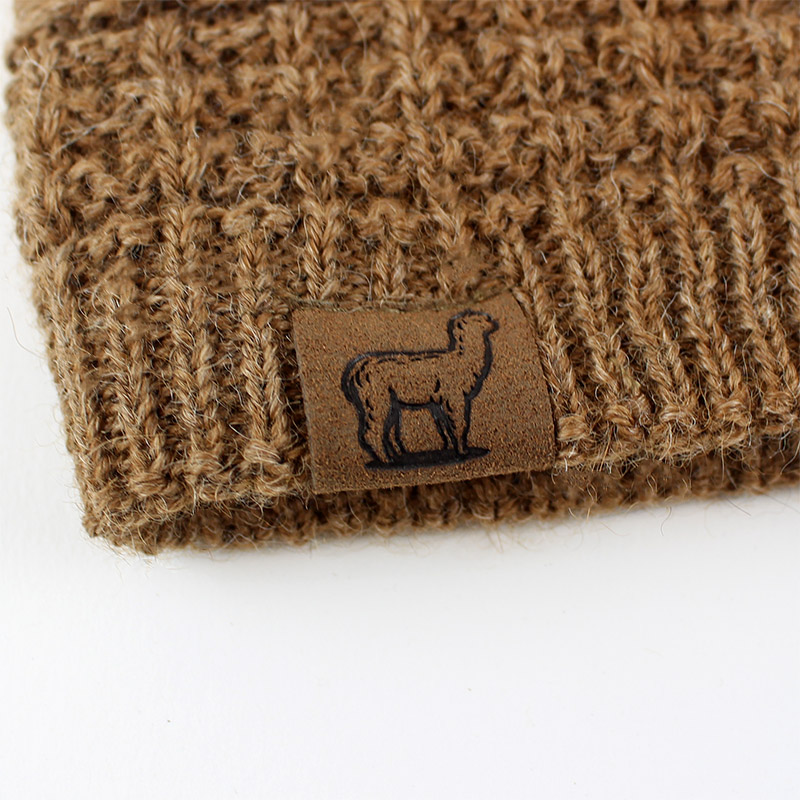
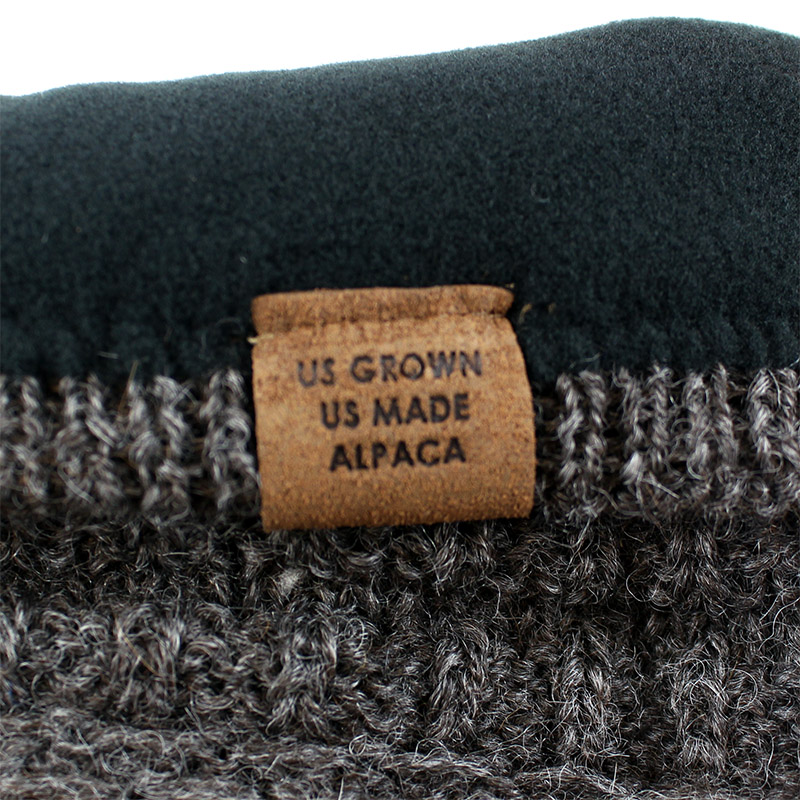
We've designed this hat in house from the ground up to be as stylish as it is warm and cozy and we couldn't be happier with the results!
The story behind this homegrown product is as good as it feels. The natural and renewable alpaca fiber used to make it is grown by small U.S. alpaca farms. Century old textile mills spin this fiber into yarn and a 4th generation family run knitting mill knits the fabric. Then the fabric comes back to us here at NEAFP where we cut, sew, and finish the fabric into a finished hat. From there it goes back to alpaca farms to share with their local communities, truly coming full circle! This is what makes U.S. Grown, U.S. Made Alpaca feel so good.
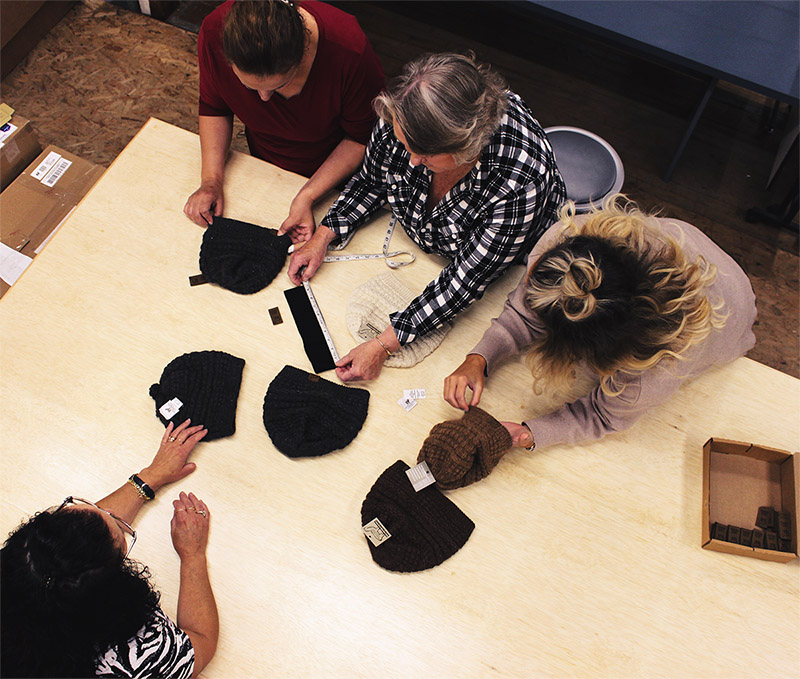
- Content: Outer Shell: 80% U.S. Alpaca, 20% Recycled Nylon. Inner Headband Lining: 100% Microfleece
- Care Instructions: Hand Wash Cold Water, Lay Flat to Air Dry
- Suggested Retail: $54
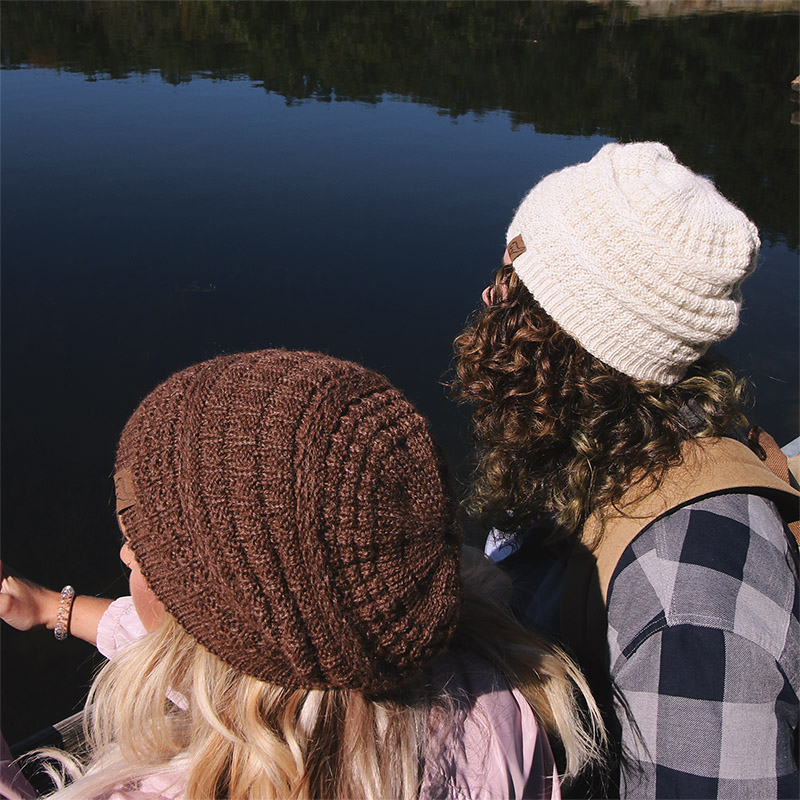
NEW Downloadable Content: The 16 Standard Colors of Alpaca Fiber
Find it here on Facebook, or download a full-size, printer-friendly version at the bottom of this article!
Check out our other downloadable graphics in previous blog posts:
3. Earth Day: The Sustainable Alpaca
4. Celebrating Motherhood: Alpaca Mothers & Crias
5. 5 Great Reasons to Visit Your Local Alpaca Farm
Feel free to share this graphic online or print it and use it at your next farmer's market as an educational resource.
Download the printer-friendly files here!
PDF Download - The 16 Standard Colors of Alpaca Fiber
High Resolution JPG Download - The 16 Standard Colors of Alpaca Fiber
Have an idea for a future graphic? Email us your ideas to support@neafp.com
NEW Downloadable Content: 5 Great Reasons to Visit Your Local Alpaca Farm
Just in time for National Alpaca Farm Days on September 28th and 29th!
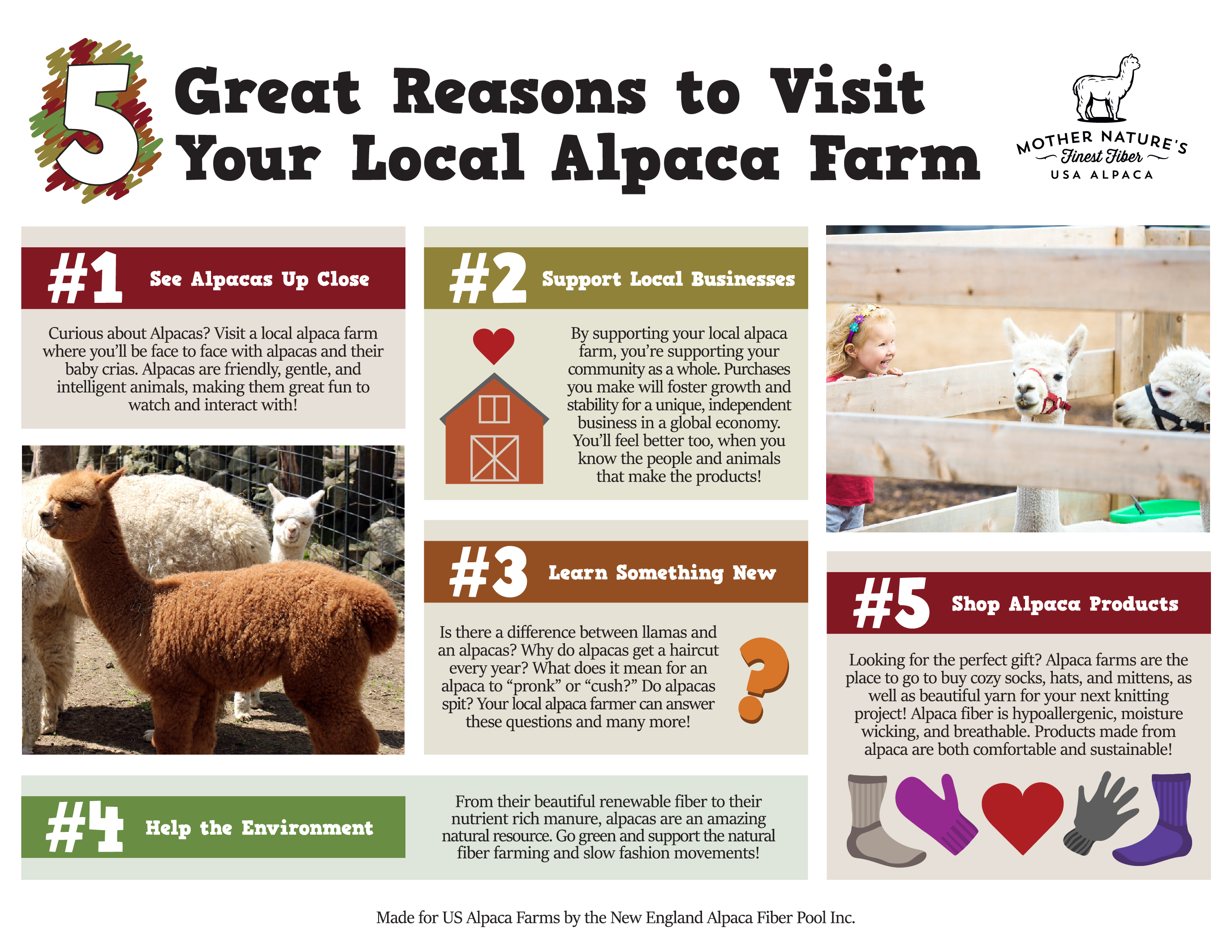
Find it here on Facebook, or download a full-size, printer-friendly version at the bottom of this article!
Check out our other downloadable graphics in previous blog posts:
3. Earth Day: The Sustainable Alpaca
4. Celebrating Motherhood: Alpaca Mothers & Crias
Feel free to share this graphic before your National Alpaca Farm Day event or print it and use it at your next farmer's market as an educational resource.
Download the printer-friendly files here!
PDF Download - 5 Great Reasons to Visit Your Local Alpaca Farm
High Resolution JPG Download - 5 Great Reasons to Visit Your Local Alpaca Farm
Have an idea for a future graphic? Email us your ideas to support@neafp.com


